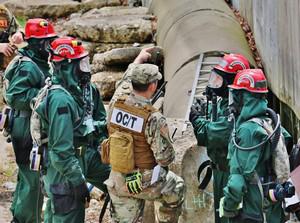First respondersAI helps protect emergency personnel in hazardous environments
Whether it’s at rescue and firefighting operations or deep-sea inspections, mobile robots finding their way around unknown situations with the help of artificial intelligence (AI) can effectively support people in carrying out activities in hazardous environments.

AI expected to aid first responders // Source: vaguard.dodlive.mil
“Rapid Assistance in Rescue Operations” and “Moving Autonomously Under Water” – Plattform Lernende Systeme Identifies Conditions and Action Plans for These Scenarios
Whether it’s at rescue and firefighting operations or deep-sea inspections, mobile robots finding their way around unknown situations with the help of artificial intelligence (AI) can effectively support people in carrying out activities in hazardous environments. The potential as well as the concrete benefits of AI in this field are illustrated in a current report from Plattform Lernende Systeme, Germany’s Platform for Artificial Intelligence, using two application scenarios. The report was presented today at Karlsruhe Institute of Technology (KIT) where scientists are involved in the platform. The authors also identify technical and social challenges, as well as conditions that need to be created for the reliable and economic use of AI in life-hostile environments.
KIT says that in the future, mobile self-learning robots can relieve people from dangerous or harmful activities. At the same time they can make operations in difficult-to-access terrain more economic or possible in the first place. For using such self-learning systems in life-hostile environments some challenges still need to be overcome from a technical point of view, however. These include autonomous learning in unknown environments. In addition, it’s about making these autonomous robots collaborate with people.
“The use of artificial intelligence comes with enormous opportunities for our society. Especially in disaster prevention, the decommissioning of nuclear power plants and in the maritime field there are a number of options for effectively supporting professionals with the help of artificial intelligence. This is why Plattform Lernende Systeme has set up an interdisciplinary work group to discuss how self-learning systems can be developed and used in life-hostile environments for the benefit of people,” says Professor Holger Hanselka, President of Karlsruhe Institute of Technology and a member of the Steering Committee of Plattform Lernende Systeme. “IT security will be extremely important particularly in the autonomous systems that we use in the event of a crisis. As a result, in its research KIT is looking at not only protecting the periphery of a complex IT system but also each individual part, particularly adding its expertise in IT security to Plattform Lernende Systeme.”
The Life-Hostile Environments work group is using two application scenarios in its report to show how artificial intelligence can offer support in disaster prevention as well as exploration and maintenance missions in around five years. The “Rapid assistance in rescue operations” application scenario illustrates how AI-based robotic systems can support the fire department on the ground and from the air in putting out a fire in a chemical plant. With the help of multiple sensors, the systems are able to quickly create a detailed overview of the situation, set up a communication and logistics infrastructure for rescue operations, search for injured persons and identify and reduce sources of danger. In the “Moving autonomously under water” application scenario, robotic underwater systems maintain the foundations of offshore wind power plants. They navigate independently in the deep sea, take over planning steps, and request support from divers or remote-controlled systems if needed.
Niche market with special requirements
“The demands on self-learning systems are particularly high in life-hostile environments: they have to be intelligent and robust against extreme conditions and be able to independently deal with unforeseen circumstances,” says Jürgen Beyerer, Head of the Life-Hostile Environments work group of Plattform Lernende Systeme, Director of the Fraunhofer Institute of Optronics, System Technologies and Image Exploitation IOSB and Professor for Interactive Real-Time Systems at KIT. “Until then, AI-based systems can be operated remotely by emergency personnel and the collected data used for the development of intelligent functions. With time, the systems will become more and more autonomous and will eventually be able to improve through machine learning.”
KIT notes that self-learning systems for use in life-hostile environments are still a niche market. Germany is well positioned in the development of these AI systems. The Life-Hostile Environments work group under the joint direction of Jürgen Beyerer (KIT and Fraunhofer IOSB) and Frank Kirchner (Robotics Innovation Center, German Research Center for Artificial Intelligence and the University of Bremen) identifies concrete action plans in its report to exploit the opportunities of self-learning systems in life-hostile environments and to serve worldwide markets with these self-learning robots. These plans range from setting up suitable infrastructures – such as comprehensive data pools and reference platforms – and promoting innovations through competition and technology demonstrators to creating standards for industry and research as well as making the procurement market more flexible.
— Also see The Self-Learning Systems in Life-Hostile Environments report; a multimedia report and info graphics on the Rapid Assistance in Rescue Operations application scenario; The “Moving Autonomously Under Water” info graphics can be downloaded at: https://www.plattform-lernende-systeme.de/anwendungsszenarien.html?file=files/img/Anwendungsszenarien/OffshoreWindkraft_webversion_20190225_1500.jpg
